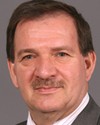Mr. Chairman, may I add something?
I would like to add a few words.
I remarked earlier about the fact that in the Great Lakes, at least, there are designated areas of concern, and in some of these areas of concern, contaminated sediments are the heritage stocks that I think you're referring to.
So, if I understood your question,
these sediments could be factors that contribute to the reason that these are designated as areas of concern. The remedial actions plans that are developed for each one of them can be different in how they address these legacy stocks of contaminated sediments. In some cases the decision is made, based on science and cost, to actually dredge and remove them, and in some cases the decision is made to leave them or cover them. It's almost on a case-by-case basis, depending on what science tells the managers of these remedial action plans and the government agencies is the risk.
Did I answer your question?




